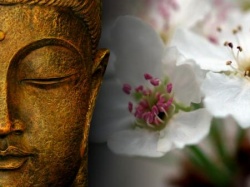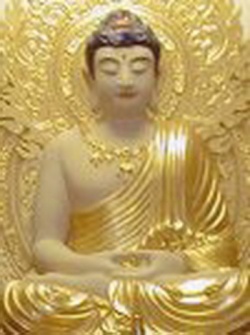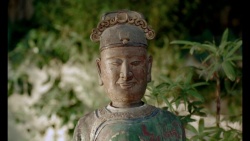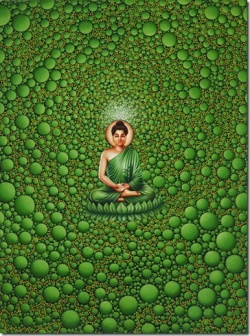The ‘short Cut’ To Nirvana: Pure Land Buddhism
by George Chryssides
Religious goals are ambitious, often seemingly beyond the reach of ordinary mortals. Particularly when humankind’s Lokeshvararaja spirituality seems at a low ebb, pessimism may set in.
‘Pure Land’ Buddhism took its rise at a time when people’s spiritual standards seemed low. Human conditions made it difficult to follow any spiritual path successfully, and nirvana seemed far remote from everyday human life. Why should one wish to take up
life as a monk (the Theravadin ideal) when many people were striving instead to make life better on earth? The monastic ideal seemed to devalue life as a layperson. The Buddha had said, ‘You yourselves must strive,’ yet the effort was surely very great indeed. After all, did not the Buddha himself take at least 530 successive existences before gaining enlightenment under the pipal tree in Bodh Gaya?
From the twelfth century onwards, these were the issues which led some Buddhists in Japan to believe that attaining nirvana was not a live option for the majority of people, and that it would be more realistic to settle for a second best alternative. In this present life one could lay the foundations for gaining merit which would eventually lead to nirvana, and perhaps one could be reborn in an existence where attaining nirvana would be infinitely easier. Some earlier scriptures, such as the Lotus Sutra1
had indicated that there was a celestial paradise from which one could be directed to nirvana. This ‘Pure Land’ (or ‘Sukhavati’, as it is called) was created by the buddhas, and the pilgrim who reached it would have an extremely pleasant sojourn there, and the bodhisattvas would show the devotee the way to nirvana without any further rebirth being necessary. Once the pilgrim reached the Pure Land, nirvana was assured. (The ‘Pure Land’ is not, of course, nirvana itself, but only a stepping-stone.)
Pure Land Buddhism has sometimes been called ‘the school of the short cut’ since it seems to offer an easier alternative to rigorous monastic life, involving simple devotion and reliance on a buddha’s compassion to make spiritual progress.
The Story of Amitabha
The focus of Pure Land Buddhism is never the historical Buddha Gautama. A number of buddhas are commonly associated with the Pure Land cults, the most popular being the Buddha Amitabha. Unlike Gautama, Amitabha was not a figure in recorded human history. Indeed the Pure Land scriptures state that he lived ‘kotis of years’, or several ‘kalpas’ before Gautama. (A
‘koti’ is defined as the number of grains of sand along the banks of the River Ganges, and a ‘kalpa’ is 420 million years: so a historically impossible time-scale puts Amitabha outside the realms of human history.)
Pure Land scriptures tell the following story of Amitabha. There was once a monk called Dharmakara who solemnly resolved to become a buddha. He was already familiar with the doctrine of the Pure Land, and asked his teacher, a buddha by the name of Lokeshvararaja, to describe this celestial paradise. It took Lokeshvararaja many years to describe the perfections of the Pure Land and, after listening to this teaching, Dharmakara resolved to create a country which not only possessed the virtues that his teacher had mentioned, but also the excellent qualities of every other buddha-country associated with every past buddha.
The Pure Land which Dharmakara described would contain no hell-beings, no animals, no hungry ghosts, no asuras (four of the six realms of rebirth), and would only contain gods and humans. The paradise would be so excellent that these two states (being a god and being a human) would be indistinguishable. There would be no ‘falling away’: once in the Pure Land, there would be no further rebirth before nirvana was reached. The land would contain countless citizens, infinite light, insurpassable
quality of life, no misdeeds, and perfect knowledge of the Dharma. Dharmakara continued his speech to describe scented rivers, trees blown by gentle breezes, perfumes, jewels, incense, flowers and music, exotic birds , freedom from all worries and misfortunes, and bodhisattvas continually worshipping the Buddha. In the course of describing this Pure Land, Dharmakara made a vow. He would not attain enlightenment unless every living being who called on his name was guaranteed citizenship in this buddha-country:
If those beings who in immeasurable and innumerable Buddha countries, after they have heard my name, when I shall have obtained Bodhi [[[enlightenment]]], should direct their thought to be born in that buddha country of mine, and should for that purpose bring their stock of merit to maturity, if these should not be born in that Buddha country, even those who have only ten times repeated the thought (of that Buddha country), barring always those beings who have committed the (five) unpardonable sins, and who have caused an obstruction and abuse of the good Law, then may I not obtain the highest perfect knowledge.2
(The five ‘unpardonable’ misdeeds in Buddhist thought are: killing one’s father, killing one’s mother, killing an arhat, shedding the blood of a buddha, and causing schism in the Sangha. One important Pure Land scripture suggests that entry into the Pure Land is impossible after such misdeeds. Other Pure Land scriptures, however, are more lenient and suggest that cardinal offenders can still obtain nirvana by invoking Amitabha’s assistance, but with infinitely greater difficulty.)
As Dharmakara made his vow, the earth began to tremble, hundreds of musical instruments were heard in the sky, sandalwood was scattered from the heavens, and a loud voice exclaimed, ‘You will be a buddha in this world.’ So Dharmakara became the Buddha Amitabha (‘Amitabha’ means ‘possessing infinite light’). Dharmakara’s vow was that he would not become a buddha unless every living being was born in his Pure Land; therefore devotees of Amitabha expect not only that they themselves will be reborn in his paradise, but that everyone who calls upon his name will reach it and be shown the way to nirvana.
Invoking Amitabha
Although Pure Land Buddhism had its hey-day in eleventh-century Japan, it first gained ground in China. A Buddhist teacher by the name of Shan-tao (seventh century) was himself believed to be an incarnation of Amitabha. He distributed many copies of the Pure Land Sutra, and wrote a commentary on it which recommended nembutsu, the
practice of calling on Amitabha’s name. He also taught that followers should chant the sutras (scriptures), meditate on the Buddha, and worship him by means of buddha-images in shrines.
Shan-tao’s work inspired a Japanese monk called Honen (1133-1212 CE), who was the founder of the Jodo school. (‘Jodo’ is Japanese for ‘Pure Land’.) Honen wrote a popular treatise, believing that Buddhism was not for monks only, but that ordinary men and women too should be able to understand enough Buddhist teaching to obtain liberation. Honen taught that, by and large,
traditional scriptures were too difficult for the average layperson to understand. But the grace of Amitabha was so great that the gaining of liberation need not depend on understanding the complexities of Buddhist philosophy. The sutras he said, were unnecessary: only devotion was required. Constantly repeating the name of Amitabha was sufficient. When other monks saw Honen’s popular book, they were so disgusted with it that they burned as many copies as they could find, but this did not prevent the spread of Jodo Buddhism.
Another famous Pure Land teacher was Shinran, a disciple of Honen. Shinran’s sect is sometimes called ‘Jodo Shinshu’, the ‘True Pure Land Sect’. His is the most popular form of Pure Land Buddhism in Japan today, having 13 million followers, in contrast with Jodo, which has only around 4 million. There are other minor Jodo sects in Japan, only sustaining a following of a few thousand each.
Shinran was a monk who deliberately discarded his robe and refused to shave his head, in order to show that people did not have to follow the monastic life to attain nirvana. He also married and had children. He preferred to preach in Japanese villages, rather than in the towns, so that simple people too would hear his message. In contrast to Honen, he claimed that any attempt to gain merit through good deeds was futile, for devotion alone brought merit. Evil people as well as good ones would be welcomed to
Amitabha’s Paradise, provided that they called upon his name, even if they only remembered to do this at the moment of their death. Unlike Honen, Shinran denied that it was necessary to repeat constantly the name of Amitabha. One repetition (nembutsu) of ‘Namu-Amida-Butsu’ would suffice; if one repeated Amitabha’s name more often, then this could be done in praise of Amitabha for his great benevolence to all living beings, but these further repetitions did not serve to make his Pure Land any easier to gain, or to enhance its benefits.
One further Pure Land teacher deserves mention. Ippen was a wandering teacher who recommended set times of the day -- six in all -- for chanting the mantra ‘Namu-Amida- Butsu’. His sect is called the Ji-shu, or ‘Times’ school. It still exists but attracts only a few thousand followers.
Distortion or development?
Opponents of Pure Land Buddhism often claim that this particular Buddhist path is a distortion of the original teachings of the Buddha. After all, did not the Buddha teach self-effort, and not liberation through some super-human figure like Amitabha? Did not the Pure Land schools substitute devotion for meditation, when the latter brought Gautama the Buddha to enlightenment? Was not
the Buddha’s emphasis on gaining ‘perfect view’, dispelling ignorance and desire, rather than on devotion? Surely the Buddhist should concentrate on eliminating desire rather than aspiring to a celestial country where all desires are satisfied? One western writer goes so far as to suggest that Pure Land Buddhists are as true to orthodox Buddhism as the Jehovah’s Witnesses are to [[Wikipedia:Christianity|Christianity]].
This last comparison is unjust. In terms of sheer numbers, Pure Land was the most popular form of Buddhism in Japan before the Second World War, only to take second place with the revival of the Nichiren sects.3 It is not particularly useful to decide whether Pure Land is ‘pure Buddhism’ or ‘true Buddhism’. It is possible that non- Buddhist influences helped to cause its development. Possibly
the plurality of buddhas derives from Hindu devotion where it is common practice to worship many forms of God, and the constant chanting of the name of Amitabha may come from the Hindu practice of invoking the gods in this way (called japa). However, all religions adapt and absorb the ideas of surrounding cultures. Pure Land is one example within Buddhism, but Tibetan Buddhism, Zen and Nichiren are equally examples of the same occurrence.
To say that Pure Land Buddhism substituted devotion for meditation is not quite accurate. To focus one’s mind on Amitabha is a form of meditation, and we have already seen4 how visualising a buddha or a bodhisattva is considered a meditative practice. Some Pure Land Buddhists also taught that there was great value to be gained in meditating not merely on a buddha-image, but on good works themselves. In fact, one cannot separate devotion and deeds: those who are truly devoted to Amitabha will not commit misdeeds, and the Pure Land scriptures clearly state that, although Amitabha receives all men and women to his paradise, whether they are good or
evil, those who have committed evil deeds will find nirvana infinitely more difficult to attain than those who have practised the Dharma and observed the precepts. Indeed, one cannot meditate on Amitabha without acquiring some of the virtues, such as compassion, which he represents. The idea of ‘transference of merit’ (performed by Amitabha) is quite consistent with traditional Buddhism also: if there are no ‘selves’, it cannot be right for me to try to gain nirvana for ‘myself’ -- I must equally be concerned with all living beings attaining nirvana, as indeed Dharmakara was when he made the famous vow which enabled him to become the Buddha Amitabha.
I do not think it is true to say that the Pure Land is presented as a place where all desires are fulfilled, and that the notion contradicts the Buddha’s teaching about ‘non- attachment’. The scriptures carefully qualify the statement about fulfilling desires: all desires are fulfilled, but ‘according to the Dharma’, they state. This makes an enormous difference: in the Pure Land, one’s requests are not granted, come what may; they are granted if they are in accordance with the teaching of the Buddha. A pilgrim who had reached the Pure Land should not expect to ask for great riches, and receive them immediately; what the sincere pilgrim must desire is spiritual benefit -- to be shown the path to full nirvana, which lies beyond the Pure Land.
Certainly, there are enormous differences between Pure Land and Theravada Buddhism. Gautama the historical founder is clearly less important to the Pure Land Buddhists than is Amitabha, or whatever buddha acts as the focus of devotion. But if the life of a Theravada monk is more demanding than Pure Land devotion, the Pure Land Buddhist would see this as a virtue and not a vice. What is wrong with a spiritual short cut? If one is making a journey it is senseless to take a longer route than is necessary. Pure Land Buddhists believe that it is because of the Buddha’s compassion that this easier path is shown. Indeed Shinran believed that Pure Land did not offer the shorter route, but the only route, since humankind was living in an age where spiritual
development was impossible. If a Buddhist wants to attempt a more stringent set of spiritual practices, that person is welcome to do so; but Pure Land claims to offer the simplest means of reaching the goal.
© 1988, 2009 George Chryssides




